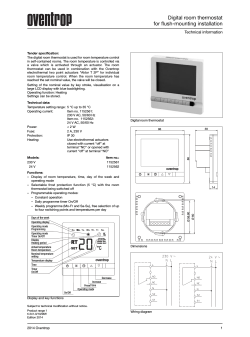
Goodman LSK-02A Installation Instructions
LSK02A & LSK03A LIQUID LINE SOLENOID KIT INSTALLATION INSTRUCTIONS ATTENTION INSTALLING PERSONNEL As a professional installer you have an obligation to know the product better than the customer. This includes all safety precautions and related items. Prior to actual installation, thoroughly familiarize yourself with this Instruction Manual. Pay special attention to all safety warnings. Often during installation or repair it is possible to place yourself in a position which is more hazardous than when the unit is in operation. Remember, it is your responsibility to install the product safely and to know it well enough to be able to instruct a customer in its safe use. Safety is a matter of common sense...a matter of thinking before acting. Most dealers have a list of specific good safety practices...follow them. The precautions listed in this Installation Manual are intended as supplemental to existing practices. However, if there is a direct conflict between existing practices and the content of this manual, the precautions listed here take precedence. DESCRIPTION This kit is for use with remote outdoor units installed with an indoor coil that uses either a fixed orifice or TXV expansion device. The purpose of this kit is to prevent refrigerant migration back to the compressor in the off cycle. The solenoid valve is installed in the liquid line of the system at either the outdoor unit or the indoor coil. We recommend installation near the outdoor unit. The normally closed solenoid valve operates on 24 volt AC power and is intended to cycle with the outdoor unit. Outdoor units that contain reciprocating compressors will require installation of a hard-start kit along with the liquid line solenoid kit. KIT CONTENTS (1) (2) (1) (1) (3) Normally Closed Liquid Line Solenoid Valve Wire Nuts Wire Bushing Installation Instruction Sheet Wire Ties INSTALLATION INSTRUCTIONS NOTE: The refrigerant must be reclaimed from the system before attempting installation of the solenoid valve. 1. Disconnect all electrical power. 2. Remove and save the control box cover from the unit. Save the screws that held it in place. 3. The solenoid valve can be installed in the liquid line at either the indoor or outdoor unit. We recommend installation near the outdoor unit for convenience. Locate the solenoid valve where it will not interfere with access to service valves when installed near the outdoor unit. IO-721B 12/2013 IMPORTANT: To avoid overheating the valve while brazing, wrap the component with a wet rag, or use a thermal heat trap compound as recommended by the compound manufacturer. Use a brazing alloy of 2% minimum silver content. Do not use flux. OUTDOOR UNIT 7. Allow the valve to cool or cool it with a wet rag before reinstalling the solenoid coil. 8. For proper leak test, evacuation, and charging procedures, see the outdoor unit installation manual or service manual. WIRING 1. Remove one of the knockouts from the solenoid valve wire connection box. 2. Install the wire bushing from the kit into the hole. 3. Use two conductor thermostat wires (supplied by the installer) to connect the solenoid valve to the condensing unit low voltage connection. Use the wire nuts from the kit to connect the thermostat wire to the solenoid valve. Route the thermostat wire along the liquid line and into the low voltage grommet and connection box. Connect one lead of the thermostat wire to the Y terminal or yellow wire and the other lead of the thermostat wire to the C/X terminal or black wire. Polarity is not important. It is not necessary to install a ground wire because grounding is provided through the valve and liquid line. SOLENOID VALVE 4. The ends of the refrigerant lines must be cut square, deburred, cleaned and be round and free from nicks and dents. Any other condition increases the chances of a refrigerant leak. 5. “Sweep” the refrigerant line with nitrogen or inert gas during the brazing to prevent the formation of copper-oxide inside the refrigerant line. The POE oils used in R-410A applications will clean any copper-oxide present from the inside of the refrigerant lines and spread it throughout the system. This may cause blockage or failure of the valve. 4. Secure the thermostat wire to the liquid line with the wire ties provided. 5. If required, install the hard start kit at this time. 6. Inspect all wiring and connections for proper installation before turning on the power. 6. Remove the solenoid coil from the valve. Note the arrow on the valve body of the valve and orient it according to the appropriate application below. Braze the valve into the liquid line. • • • 7. Reinstall the control box cover. 8. Reconnect the electrical power. For all air conditioner applications (cooling only), the arrow points away from the outdoor unit. For heat pump applications that have TXV in the outdoor, the arrow points away from the outdoor unit. For heat pump applications that have a flowrator/ piston in the outdoor, the arrow points TOWARD the outdoor unit. OPERATION The solenoid valve will be closed when the outdoor unit is off. The solenoid valve should open immediately when the outdoor unit comes on. Cycle the unit off and on to verify proper operation. NOTE: SPECIFICATIONS AND PERFORMANCE DATA LISTED HEREIN ARE SUBJECT TO CHANGE WITHOUT NOTICE Visit our website at www.daikincomfort.com, www.goodmanmfg.com or www.amana-hac.com for information on: • Products • Warranties • Customer Services • Parts • Contractor Programs and Training • Financing Options 5151 San Felipe, Suite 500, Houston, TX 77056 © 2011, 2013 Goodman Manufacturing Company, L.P. is a registered trademark of Maytag Corporation or its related companies and is used under license. All rights reserved. 2
© Copyright 2025











